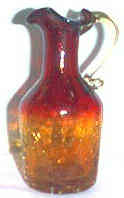
amberina glass jug
If you are looking for
Amberina Glass there
is always some for sale
on eBay. See what there
is just now -
click here 

|
Amberina Glass: A short explanation:
Amberina glass was first patented in the USA by Joseph Locke and Edward D. Libby in 1883. Locke was head designer for the Cambridge factory of the New England Glass Works (NEGW), and Libbey was the proprietor having just taken over from his father who died that year. Amberina Glass is "heat sensitive" glass, which shades in colour from amber at the bottom to red at the top. This colour shading is due to the effects of reheating the top part of the glass before allowing it to cool. Amberina glass contains a precipitate of colloidal gold (as does gold ruby glass), which is heat sensitive and turns red at the right temperature.
If the effect is reversed and the bottom part of a vessel is reheated rather than the top, the result is called "reverse amberina"- which is red at the bottom and amber at the top. Amberina glass made at Libbey's New England Glass Works was a high quality, lead-based, blown art glass, which carried a specially designed sticker showing the name and patent details. It was made from 1883 to the late 1890s. In 1888 the New England Glass Works moved from Cambridge to Toledo in Ohio and the company name was changed to W.L.Libbey & Son. In 1917 that company celebrated its centenary by reviving Amberina glass for just a short time, taking advantage of the pent-up demand for coloured glass after the Great War (1914-18). These pieces all carried an acid etched signature "Amberina" with the company name.
Mt Washington Glass Company of New Bedford, USA, also made amberina glass for a few years in the early 1880s. There was a dispute between the New England Glass Works Company and Mt Washington Glass about patent rights, which was not resolved by Mt Washington calling their amberina glass "Rose Amber", and in 1886 an injunction was granted against them and they stopped making it.
Hobbs, Brockunier and Co of Wheeling USA also made amberina glass, but they had obtained a license from Libbey/New England Glass and most of their amberina glass was pressed glass rather than blown. There were also European companies making versions of amberina glass, including the great French company Baccarat.
Amberina glass was used to make both blown art glass and pressed glass items. There are a number of variations for manufacturing the shaded amber to red colour of the original. Flashed amberina is made by applying a flashing of red glass to the top part of an amber glass item. Selenium is often used to make a cheaper version of Amberina. The colour is still popular today and is made by contemporary glass works in the USA.
|